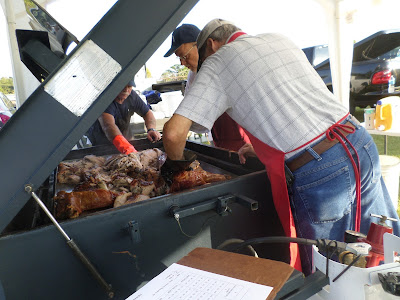Judging whole hog cookoffs is a great way to taste and evaluate excellent barbecue. Participating at events in a variety of locations opens a door to experience regional differences and styles in whole hog cooking.
 |
| Butts & Beans BBQ was one of the whole hog contestants. |
Because I traveled to at
Oinktoberfest for the
cookoff sanctioned by Kansas City Barbeque Society, I took advantage of the opportunity to judge the festival’s
whole hog competition on the next day. Being from North Carolina carries a lot of credibility at whole hog contests because the state has a well-recognized tradition of excellent whole hog cooking, particularly in its eastern areas that have a rich colonial past. In fact, the contest coordinator mentioned at the judges’ meeting that my home is North Carolina and asked me to give some examples of N.C. whole hog events.
 |
| Nancy Muller, contest official, discusses procedures with judges. |
Of course, one example that I had to use is
Newport Pig Cookin’ where 77 contestants competed this year and often more than 100 cooks participate. In contrast, at Oinktoberfest, only eight teams competed, and only seven turned in samples (one disqualified itself because the pig was undercooked); in
2015, only four competed.
 |
| Not much meat is left on the pig cooked by Butts & Beans after the cuts from the five sections have been made. |
At
Oinktoberfest, in addition to a smaller number of cooking teams, I expected to see other differences compared to events conducted by state and national sanctioning groups, such as the
N.C. Pork Council. The biggest difference is that at Oinktoberfest the entire pig is not evaluated (only cuts from a pig), and no evaluation is made at a cooking site. Instead, cooks submit samples of cuts from five sections: shoulder, loin, ribs, belly/bacon, and ham. An hour before turn-in, an observer (known as the Hog Patrol) is at a site to confirm that the cuts are made in the correct sections.
 |
| A member of the Hog Patrol is ready to observe as cuts from the five sections are made. |
Also at
Oinktoberfest, the
rules require cooking with only wood or charcoal, the “traditional” way but also more difficult to control temperature and flareups than when using gas. As a result, most pigs were charred and their brownness, moisture, and skin crispness --
major criteria of N.C. whole hog cookoffs – were less than satisfactory. Another difference is that Oinktoberfest contestants can use injections, which are prohibited in North Carolina. In addition, contestants had to provide their own hog. Perhaps to reduce expenses, many purchased a hog slightly more than the minimum weight, 40 pounds (a much lower weight than at past Oinktoberfests and significantly lower than at many events where pigs average over 100 pounds). However, the small size limits the areas to select meat. The ribs, in particular, were small and not very meaty.
 |
| Cooking a whole hog is a lot of delicate work and timing. |
Judges at Oinktoberfest were all certified
KCBS judges, who are trained to evaluate chicken, ribs, pork, and brisket. They used the same criteria – appearance, taste, and tenderness -- of KCBS for these meat categories to evaluate the samples turned in and to determine a composite score for each contestant. The judging was “blind” – judges did not know the contestants they were evaluating (unlike at most whole hog events, where judges visit sites and determine scores before leaving them).
 |
| The Tranquil Carnivores team prepares samples for turn in. |
Judging at Oinktoberfest gives me a greater appreciation for national, regional, and state organizations that sponsor and sanction barbecue competitions, particularly whole hog cookoffs, and that provide a uniform approach to achieve in a high degree of consistency among events. A lot of insight and experience is needed to develop effective rules and to establish meaningful criteria.
Oinktoberfest can be commended for bringing whole hog competition to western New York, and it will be a more effective contest as it matures and encourages more competitors to participate in whole hog cooking.
 |
| Finding the best cuts helps to achieve a higher score. |





















